 |
a web page by Don Roberson |
AUSTRALASIAN ROBINS Petroicidae |
||||
|
||||
There are plain-looking robins and flycatchers among the family, but quite a number are colorful and engaging. A fair number of the robins often perch "sideways" on a vertical trunk, and look around for prey with big dark eyes, as this Eastern Yellow Robin is doing (left). This male Flame Robin in Tasmania (below) has found a slightly elevated perch, with toadstool, in a horse pasture. |
||||
 |
||||
Jacky-Winter is one of six species in genus Microeca. The remaining congeners are yellow-bellied forest flycatchers: four in New Guinea and one in the Tanimbar Is., Indonesia. These five, plus Torrent Flycatcher Monachella muelleriana of New Guinea and New Britain, were all called "Flyrobins" in the Handbook of the Birds of the World series (Boles 2007). The current Clements checklist used Flyrobin for only two them and retains the worn-out "Flycatcher" for the rest. I strongly encourage use of the new-and-better name Flyrobins for all Microeca [maybe even the "Post Flyrobin" or "Jacky Flyrobin" for Jacky-Winter?] |
||||
|
||||
Officer (1969) summarized Gray-headed Robin Heteromyias cinereifrons this way: "When one is motoring through the rain forest approaches to the Atherton Tableland this is one of the birds most frequently seen by the roadside. When disturbed it takes cover in the heavy forest but is very soon back again." Of course this behavior now applies only to certain back road and I saw none along the heavily traveled fast main roads on a recent visit. As to the Mangrove Robin Eopsaltria pulverulenta, Officer writes: "A delightful confiding little bird but, alas, as its name indicates, a resident of the mangroves and that means inevitably the purgatory of sandflies while one is studying it." Why is it that no one writes this way any more? The somewhat larger, pied robin, reasonable widespread across Australia, is Hooded Robin (below), shown here in the the continent's "red centre." |
||||
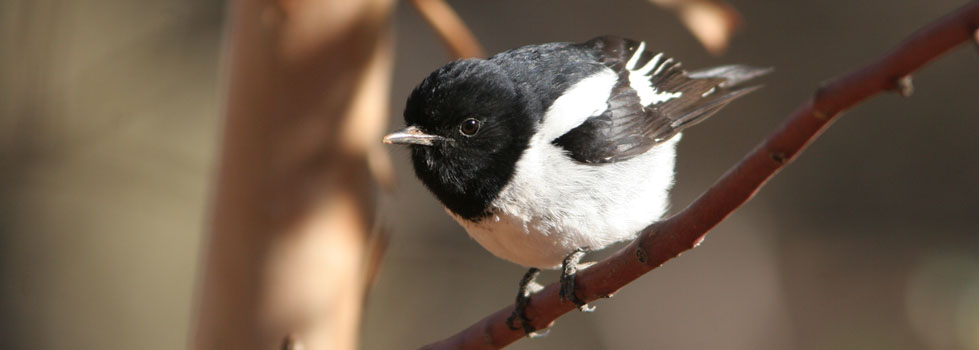 |
||||
|
||||
|
||||
|
||||
Various robins are endemic to islands east of Australia and New Guinea, including three Petroica robins on New Zealand. When I first visited New Zealand in 1997, there were just two New Zealand petroicids: New Zealand Robin and Tomtit. In those pre-digital times, I managed to photograph only a fledgling of each of them. Since then, New Zealand Robin has been split into North Island and South Island Robins, so the baby shown above (left) is North Island Robin. This recently hatched fledgling, still with its baby spots, was on Tiritiri Matangi Island off North Island. It reminds me quite a lot of a baby bluebird (Sialia). Here on this tiny islet all introduced plants have been removed, rare native birds have been re-introduced, and species like the New Zealand Robin again fill their ancient rôles. Tiritiri is remarkable because it sounds like old New Zealand — one hears a forest filled with native bird song instead of the cacophony of non-native species that dominate the aural landscape on the big islands of New Zealand. Above is a fledgling Tomtit (above right), on the main North Island in the forest around Lake Rotopounamu. Tomtit has a wide distribution through the North and South Islands, and occur on some of their offshore islands, Stewart Island, Chatham Islands, Snares Islands and Auckland Islands. Males are black-headed, females brown-headed. Some populations are white-bellied, some yellow-bellied, and those on Snares are entirely black. The male's song is given throughout the year, and has been rendered as “ti-oly-oly-oly-ho”, like a squeaky gate being opened and closed. It is said that the name "Tomtit" is shortened form of "tom titmouse," which was colloquially used to describe a number of small birds in the past. In England, "tomtit" was most commonly used as an alternate name of Blue Tit Cyanistes caeruleus. The reserve on Tiritiri Matangi is an avifaunal success story for many New Zealand endemics, but another petroicid has a success story in its own right. In 1981 the Black Robin Petroica traversi, now often called Chatham Robin, had the smallest population of any bird species for which precise figures were known: there were exactly five birds, four males and a female. It seemed doomed to extinction. Its population on the larger Chatham Islands (southeast of New Zealand) had been wiped out by rats introduced with human colonization of the island group. In 1976 only seven birds remained in deteriorated habitat on Little Mangere Island. All seven were then translocated to Mangere Island where the forest had been replanted with 120,000 new trees. In 1979, after no breeding and the loss of two birds, a program of supplemental feeding and nest protection from introduced starlings was initiated; eventually eggs and chicks were cross-fostered in the nests of its relative, the Tomtit. |
||||
The Petroicidae was once thought to be among the great Corvid assemblage that arose in isolation in Australasia (e.g., Sibley & Ahlquist 1980) but more recent molecular analysis showed them to be among the “basal passerid oscines,” which together are likely sister to the large and diverse Passerida (Barker et al. 2004, Jønsson et al. 2007, Irestedt & Ohlson 2008, Aggerbeck et al. 2014, Barker 2014). The full scope of the relationships among these ancient groups is still uncertain, but their closest relatives probably include rail-babbler (Eupetidae), rockfowl (Picathartidae) and New Zealand families such as Notiomystidae (Stichbird; e.g., Jønsson et al. 2007, 2011, Aggerbeck et al. 2014). When raised to family level, the group was initially known as the Eopsalriidae, but Petroicidae had priority (see Boles 2007). |
||||
Photos: The Eastern Yellow Robin Eopsaltria austalis was in Lamington NP, Queensland, Australia, on 1 Sep 2016. The male Flame Robin Petroica phoenicea was in the Weilangta Forest, Tasmania, Australia, on 21Aug 2008. The Jacky-Winter Microeca fascinans was near Sydney, New South Wales, Australia,in Sep 1983. The White-breasted Robin Eopsaltria georgiana was at Arpenteur Nature Reserve, Western Australia, on 7 Aug 2008. The Western Yellow Robin Eopsaltria griseogularis was in the Stirling Range, Western Australia, on 11 Aug 2008. The male Scarlet Robin Petroica boodang was in the Dryandra Forest, Western Australia, on 4 Aug 2008. The Hooded Robin Melanodryas cucullata was at Simpson Gap NP, Northern Territories, Australia, on 16 Aug 2008. The pair of White-winged Robin Peneothello sigillata was at Kumul Lodge, near Mt. Hagen, Papua New Guinea, on 10 Sep 2016. The male Black-throated Robin Poecilodryas albonotata was at Tari Gap, Papua New Guinea, on 8 Sep 2016. Simon Woolley & Julia Cassin photographed White-faced Robin Tregellasia leucops in Papua New Guinea, in Sep 2003. The baby North Island Robin Petroica longipes was on Tiritiri Matangi Island, off North Island, New Zealand, on 26 Dec 1997. The fledgling Tomtit Petroica macrocephala was at Lake Rotopounamu, North Island, New Zealand, on 26 Dec 1997. The Yellow-bellied Robin Eopsaltria flaviventris was in Parc due Riviére Bleue, New Caledonia, on 8 Jan 1998.. The Southern Scrub-Robin Drymodes brunneopygia was at Fitzgerald River NP, Western Australia, on 8 Aug 2008. All photos © Don Roberson;, except the White-faced Robin attributed © Simon Woolley & Julia Casson, and used with permission; all rights reserved. Bibliographic note: There is no recent "family book" covering the Petroicidae but a good introduction, with great photos, is in Boles (2007). Prior to that chapter in the Handbook of the Birds of the World, excellent photos and information about Australian and New Guinea species are found in Frith (1979) and Coates (1990), respectively. I also have in my library a slim volume entitled Australian Flycatchers (Officer 1969) that includes the Australian species of the Petroicidae — the Australian robins — back at a time when they were considered part of the Old World flycatcher assemblage. It is a fairly simple rendition of field marks, habitat, and basic biology but is nicely illustrated with plates by Peter Slater and has a "you are there" quality to the writing that whets one's appetite to see these birds. Literature cited:
|
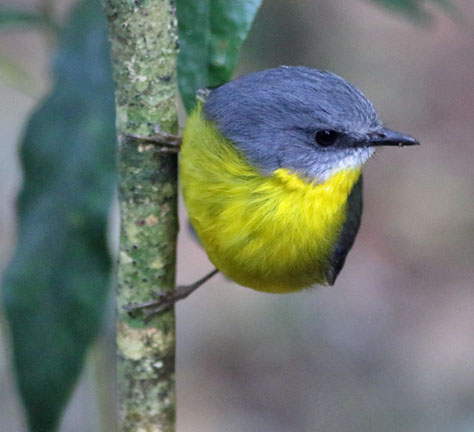 The Petroicidae is an Australasian family of small flycatchers, most of them called "robins." They are not closely related to Eurasian "robins," which are muscicapids [Muscicapidae], nor to New World "robins," which are thrushes [Turdidae]. These Australo-Papuan flycatchers evolved in isolation and now fill a niche not unlike the "robins" and "chats" among the Muscicapidae. They are examples of convergent evolution. Australasian robins are characterized as small, big-headed, thick-necked, fat-bodied, and short-tailed passerines that typically sit upright, like a a flycatcher, and generally perch rather low. The Petroicidae are less inclined to be aerial than other "flycatchers" around the world. There are exceptions to most of these characteristics among the 49 species in 13 genera in the family, but many fit that description.
The Petroicidae is an Australasian family of small flycatchers, most of them called "robins." They are not closely related to Eurasian "robins," which are muscicapids [Muscicapidae], nor to New World "robins," which are thrushes [Turdidae]. These Australo-Papuan flycatchers evolved in isolation and now fill a niche not unlike the "robins" and "chats" among the Muscicapidae. They are examples of convergent evolution. Australasian robins are characterized as small, big-headed, thick-necked, fat-bodied, and short-tailed passerines that typically sit upright, like a a flycatcher, and generally perch rather low. The Petroicidae are less inclined to be aerial than other "flycatchers" around the world. There are exceptions to most of these characteristics among the 49 species in 13 genera in the family, but many fit that description. 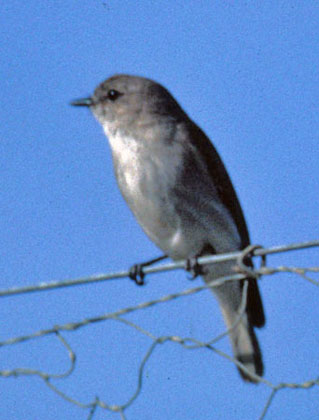 One of the most familiar birds in the family bears the odd name of Jacky-Winter (right). It is an Australian bird that ranges (barely) to southern New Guinea. Alternative colloquial names include "Stumpbird", ‘Post Sitter," and "Postboy," arising from its habit of perching on bare stumps or fence-posts, gently wagging its tail from side to side in a shallow figure-of-eight. They are also sometimes locally known as ‘Peter Peter" — a crude rendition of their song, uttered incessantly during the breeding season — and if repeated in threes, might be rendered as "pretty–pretty–pretty" (Boles 2007). I had guessed that the archaic name Jacky-Winter came from its seasonal occurrence, but I was very wrong. The species is everywhere mostly resident, with some limited seasonal movements. No one seems to know for sure, but "Jacky-Winter" may also be a play-on-words related to its song.
One of the most familiar birds in the family bears the odd name of Jacky-Winter (right). It is an Australian bird that ranges (barely) to southern New Guinea. Alternative colloquial names include "Stumpbird", ‘Post Sitter," and "Postboy," arising from its habit of perching on bare stumps or fence-posts, gently wagging its tail from side to side in a shallow figure-of-eight. They are also sometimes locally known as ‘Peter Peter" — a crude rendition of their song, uttered incessantly during the breeding season — and if repeated in threes, might be rendered as "pretty–pretty–pretty" (Boles 2007). I had guessed that the archaic name Jacky-Winter came from its seasonal occurrence, but I was very wrong. The species is everywhere mostly resident, with some limited seasonal movements. No one seems to know for sure, but "Jacky-Winter" may also be a play-on-words related to its song.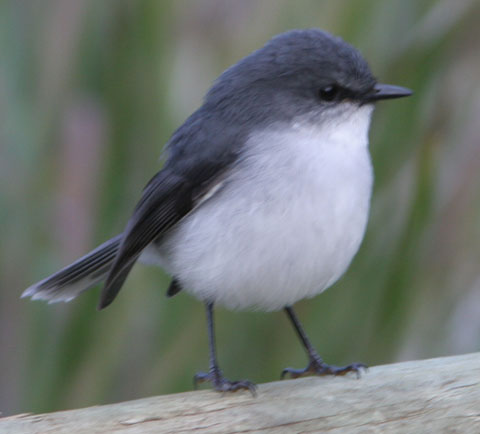

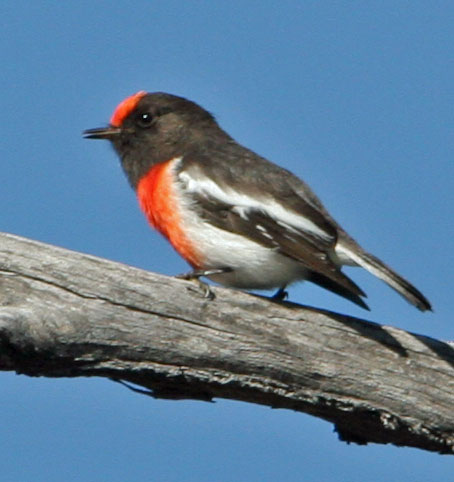 Thirteen of the Petroicidae are Australian endemics but almost half (18) are confined to New Guinea; another four are mostly New Guinea species whose range extends to northeast Australia. The robins of Australia are often colorful: 5 species in genus Petroica, 4 in Eopsaltria, and two in Melanodryas. They are only mildly "flycatcher-like" and behave more like small robins or thrushes in many ways. Examples include two Eopsaltria robins from southwestern Australia — White-breasted Robin (above left) and Western Yellow Robin (above right) — and an Australian Petroica that occurs in both southwest and southeast Australia, and Tasmania: Scarlet Robin (left).
Thirteen of the Petroicidae are Australian endemics but almost half (18) are confined to New Guinea; another four are mostly New Guinea species whose range extends to northeast Australia. The robins of Australia are often colorful: 5 species in genus Petroica, 4 in Eopsaltria, and two in Melanodryas. They are only mildly "flycatcher-like" and behave more like small robins or thrushes in many ways. Examples include two Eopsaltria robins from southwestern Australia — White-breasted Robin (above left) and Western Yellow Robin (above right) — and an Australian Petroica that occurs in both southwest and southeast Australia, and Tasmania: Scarlet Robin (left). 
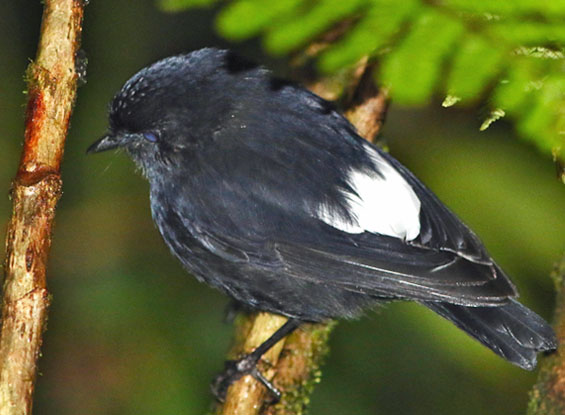
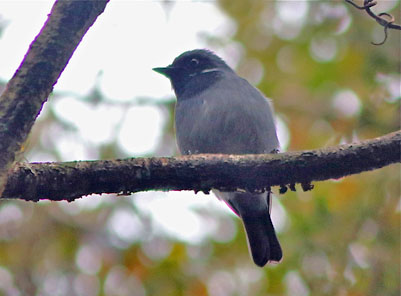
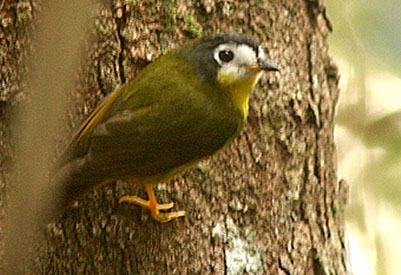
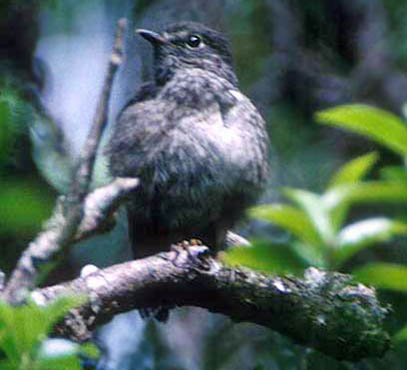
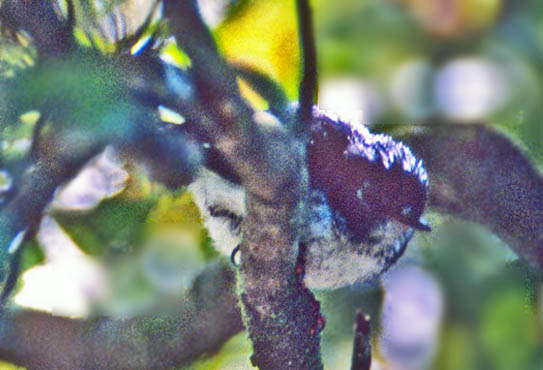
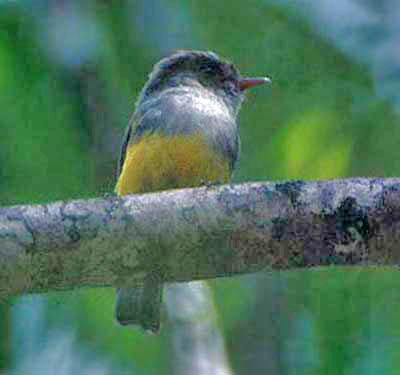 Additional Petroica robins reside on Norfolk Is. (held by Australia), another (Pacific Robin P. pusilla) ranges in the south Pacific from the Solomon Islands to Vanuatu and Fiji, and a third on the Chatham Is. (held by New Zealand; more on that below). A final island robin is a yellow-bellied Eopsaltria robin on New Caledonia, called Yellow-bellied Robin (left). It is a bird restricted to the remaining lowland rainforest on that French-held island.
Additional Petroica robins reside on Norfolk Is. (held by Australia), another (Pacific Robin P. pusilla) ranges in the south Pacific from the Solomon Islands to Vanuatu and Fiji, and a third on the Chatham Is. (held by New Zealand; more on that below). A final island robin is a yellow-bellied Eopsaltria robin on New Caledonia, called Yellow-bellied Robin (left). It is a bird restricted to the remaining lowland rainforest on that French-held island.  The final set in the Petroicidae are three scrub-robins in genus Drymodes. These are not related to ten scrub-robins in Africa and the Middle East (genus Cercotrichas) that are muscicapids ("Old World flycatchers") in Family Muscicapidae. Two of the Drymodes scrub-robins are rainforest understory species in New Guinea (Papuan Scrub-Robin D. beccarii) and on the Cape York Peninsula, Australia (Northern Scrub-Robin D. superciliaris). Southern Scrub-Robin (right) is a bird of the Australian mallee and other arid scrub. The one shown here was living in thick mallee and was only seen because it perched up to sing. All the Drymodes scrub-robins are secretive and elusive, and best located by vocalizations.
The final set in the Petroicidae are three scrub-robins in genus Drymodes. These are not related to ten scrub-robins in Africa and the Middle East (genus Cercotrichas) that are muscicapids ("Old World flycatchers") in Family Muscicapidae. Two of the Drymodes scrub-robins are rainforest understory species in New Guinea (Papuan Scrub-Robin D. beccarii) and on the Cape York Peninsula, Australia (Northern Scrub-Robin D. superciliaris). Southern Scrub-Robin (right) is a bird of the Australian mallee and other arid scrub. The one shown here was living in thick mallee and was only seen because it perched up to sing. All the Drymodes scrub-robins are secretive and elusive, and best located by vocalizations.